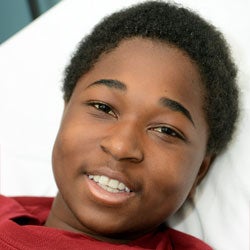Sickle Cell Disease
For 13-year-old Jacob Smitherman, sickle cell disease has always been a part of life – he was diagnosed in utero. His parents both carried the sickle cell trait, prompting doctors to perform an amniocentesis when his mother was five months pregnant. “He is blessed that he has not had any serious complications with his sickle cell,” Jacob’s stepmother, Cortelyou Smitherman, said. “For him, it has been more about managing it and getting the right medications. Thankfully, his doctors at Children’s have helped do that from the very start.” Jacob’s daily medication regimen was penicillin when he was an infant. When he was 4 years old, his doctors stopped the penicillin and started him on blood transfusions. “His stroke levels were staying too high,” Cortelyou said. “He was at a higher risk of stroke on one side of his brain, so the transfusions were started mainly for prevention.” Jacob began visiting Children’s every month for his transfusions, sometimes twice a month depending on his stroke risk percentage. “Getting 4-year-olds to cooperate with IVs isn’t an easy task, but everyone at Children’s would do such a great job with him,” Cortelyou said. “They would do whatever possible to comfort him and make it as easy on him as possible.” Doctors eventually discontinued the IVs and replaced them with a Mediport. At age 8, Jacob was able to stop the transfusions. He was prescribed another medication, but one day he began running a high fever and experienced headaches. He was rushed to the emergency room at Children’s and later admitted. Jacob also complained of pain in his knee, and a CT scan and ultrasound revealed osteomyelitis – an inflammation caused by an infection that can be triggered by the sickle cell disease. The infection caused Jacob’s headaches and fever, and he was admitted to Children’s for about a week. “His treatment required frequent doses of antibiotics through an IV,” Cortelyou says. “In order for him to go home he had to have a PICC line placed to continue the antibiotic treatment at home. That helped a lot because we were able to be at home and he could still get his treatment. They also assigned a home health nurse to come out once a week to clean and change his dressing on his PICC line. Children’s really made sure to meet Jacob’s needs and do whatever they could to help make the entire process easier.” Today, Jacob continues to visit Children’s monthly for transfusions. While it has become just another part of his routine, he and his family are thankful for the continued care they get so close to home. “Children’s has been amazing,” Cortelyou says. “They have taken such good care of him over the years. We still see many of the same people that were there from the very start and they have become like family to us. They have really gotten to know Jacob and obviously care so much about him. We can’t imagine going through this experience anywhere else.”











